“Your stomach is empty since yesterday. Let me make you some soup,” said the monk to me as I took deep breaths to try and get more oxygen to my altitude-sickened body, “it may help with your nausea too.” As I nodded weakly, he went back into the kitchen, in his home under the great Kee Gompa (Monastery), an 800-year old outpost of Tibetan Buddhism perched on a rocky outcrop high above the Spiti river in Himachal Pradesh, India. I had been sent to the monastery in a hurry the previous night by my ecologist friend Charudutt Mishra, part of the High Altitudes Program of the Nature Conservation Foundation and Director of Science and Conservation for the International Snow Leopard Trust. We were visiting the NCF base camp in the nearby village of Kibber, from where Dr. Mishra has been building community-based wildlife conservation programs for a decade and a half, focusing on the larger vertebrate fauna of Spiti Valley. Starting from the plains of Punjab three days earlier, we had made good progress driving through the Great Himalayan Range to reach this trans-Himalayan village the previous day, but the thin air at 4200 meters above sea level finally got to me. When Charu noticed my symptoms worsening in the night, he rushed me back to a lower elevation, to the care of his friend, the Lama (monk) at this ancient monastery.
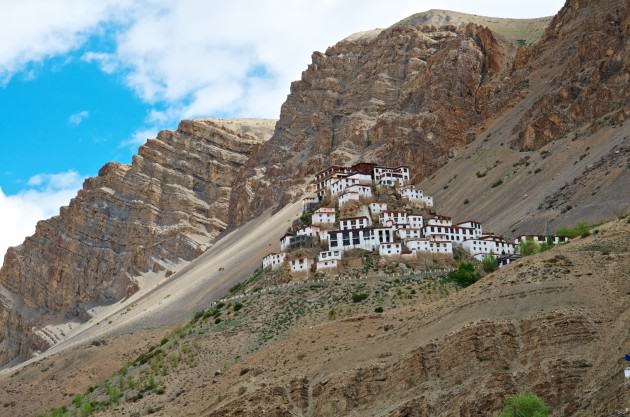
Expecting a nourishing broth from some age-old mountain recipe, I eagerly took the steaming bowl, only to find a more familiar ajinomoto flavor and the crunch of dehydrated peas and carrots. The puzzle was solved when I went to put the empty bowl into the kitchen sink and noticed the empty packet of Knorr-brand instant soup by the stove! So even those seeking spiritual enlightenment deep in these ageless young mountains weren’t above using packages of instant noodle soup. Communities living in this remote valley, near the India-Tibet border, have always depended upon trade with outside communities for many essential goods, and have thus (not surprisingly, even if it seems incongruous at first glance) embraced many elements of modern technology, including processed packaged foods. Thus it was that I came to be drinking instant soup in that ancient monastery that morning, and began to contemplate the reach of the forces of globalization and urbanization. That bowl of soup brought into sharp relief the true extent of rapid urbanization in India, which I had recently written about (with Harini Nagendra, a contributor to TNoC, and several other colleagues) in a report assessing urban growth and its consequences for biodiversity and ecosystem services in India, for the UN Convention on Biological Diversity.
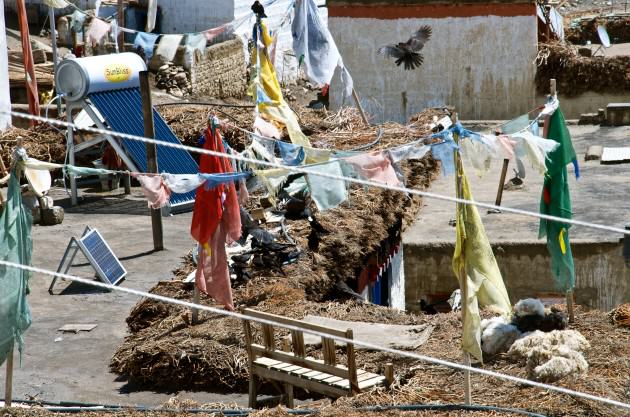
That package of instant soup began its life as a product in a factory thousands of miles away from the monastery, its vegetable contents coming from farms even farther away. Now the empty plastic pouch was going to land in a rubbish pile somewhere on the sides of this breathtakingly beautiful mountain, and perhaps eventually find its way into the roaring Spiti river to be swept back down towards the plains whence it came. For the monastery, like every other settlement in the valley—and indeed, like every urban area in the world—has a growing garbage disposal problem.
Garbage, especially of the non-recyclable plastic variety, littering the hillsides in such a remote valley? Tribal settlements and Buddhist monasteries surrounded by piles of rubbish, in turn overrun by packs of feral dogs? These were unthinkable when Mishra and his colleagues at NCF started working on the ecology of the people, wild ungulates and snow leopards in this region nearly two decades ago. Just as unthinkable as the Facebook apps on cellphones in nearly every villager’s hands, the ATMs dispensing cash in remote towns, or the televisions bringing international cricket tournaments and advertisements for hair and skin products into many homes now electrified and plugged into the global grid. For the once sleepy settlements in these remote mountains, which only drew hardy souls from the plains seeking refuge and spiritual enlightenment in nature, away from the bustle of modern industrial civilization, have now turned into outposts along the rapidly urbanizing fringe of that very civilization. This urbanization has no doubt improved many human lives, helping solve some age old problems with modern technology, but also creating new ones threatening both human health and the biodiversity of this fragile desert ecosystem.
How can one look at a village like Kibber, with its 75 households of mostly mud houses with roofs fringed by tangled bunches of Caragana twigs, clustered tightly amid fields of peas and barley, and pastures with herds of goats, sheep, donkeys, cows and yaks, on the edge of a wildlife sanctuary, and think “urban”? Surely, these villages must still be outside most definitions of “urban”?
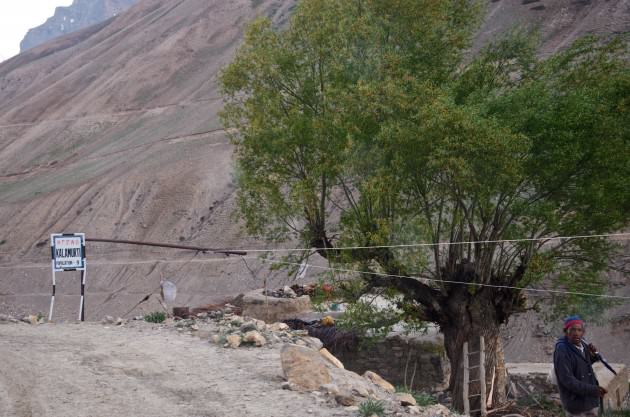
The growing scientific literature on urban ecology is filled with attempts to define “urban” in consistent, measurable, quantitative ways. These include many criteria upon which most of us urban ecologists agree, yet there isn’t a single clear definition of what it means for a human settlement to be called “urban”. Often many of us settle on gradients encompassing a range of variables along some rural-to-urban axis, with somewhat arbitrary cut-offs to separate our cities from villages and hamlets. This does not include the many social institutional / governmental definitions of “village”, “town”, and “city”, which only add further layers of confusion for an urban ecologist trying to identify the limits of her study area, the urban ecosystem. It seems so much easier to identify and delimit the boundaries of other “natural” ecosystems on this planet now being blanketed by this new type of ecosystem which is connected with the far corners of the Earth through modern transportation and communication networks bringing together energy, materials, organisms, and ideas, and mixing them up with scant regard for any natural ecosystem boundaries.
How does one properly define (and delimit the extent of) “urban” in such a dynamically networked system? Where do we place a Kibber village, or the settlement around Kee monastery, along any of our rural-to-urban gradients? And on what basis? It might help to take an ecological (or social-ecological) approach, and examine the nature of these settlements in terms of their structure, composition, and the functional processes governing their dynamics.
Is Kibber a village or an urban outpost, and does it matter how we define it?
The small population size (75 households and growing) and geographical footprint (~0.25 sq.km built area) would seem to place Kibber firmly at the rural end of any urbanization gradient. But let us take a closer look at this village, in terms of key characteristics that are important in understanding the dynamics of urban ecosystems. Kibber is a permanent settlement composed of solid houses many of which are many decades old. The Kee Monastery, a few kilometers below, is many centuries old. The houses and monastery buildings, while mostly built from earth and other local materials, are solid structures that clearly distinguish them from the surrounding landscape. Newer buildings include an increasing quotient of concrete in their construction, even though it has much poorer insulation properties for the harsh winters of this high-altitude desert region.
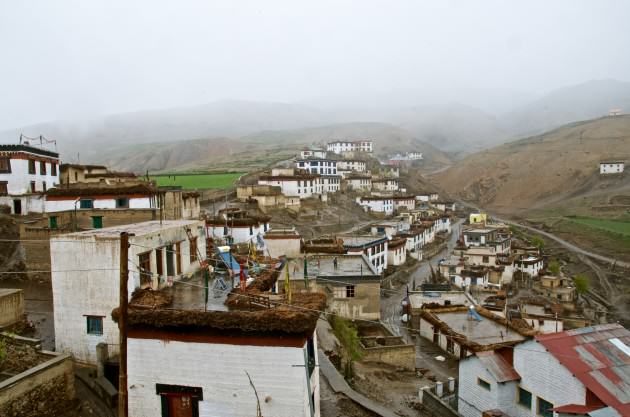
The road winding through these settlements may not be paved everywhere with asphalt, but its surface is compacted from the pounding of hooves of livestock, and the tires of SUVs which now churn up the dust. The alleys and footpaths networking through the village are likewise compacted. All of which results in making these settlements much more impervious than the surrounding landscape, with storms resulting in muddy runoff and floods. The extent of impervious surface cover is a key feature of urban ecosystems, and these villages are well on their way along that gradient, despite their lack of paved roads and concrete.
While the total population and area of Kibber are small, the population and housing density are both quite high because this is a compact mountain settlement, with houses huddled together for warmth during the long winter months. The close clustering of the houses, and the fires in the hearths within, also result in local “heat island” like effects—and that is surely by design rather than a by-product of concrete and asphalt surfaces. The settlement is too small perhaps to have any significant impacts on the local climate, but it has clearly altered the flow of many materials and energy from the surrounding ecosystem. Long-term agriculture and human settlement throughout the valley, even at relatively low density, has altered the hydrology of the upper watersheds, with small dams, canals and pipes built to divert water into the farms and villages. These are now augmented by mini-(and larger) hydroelectric projects generating electricity to power the districts all along the Spiti and Sutlej rivers. Roads further alter water flows by stabilizing / destabilizing the slopes and creating new channels of flow.
Farming and livestock herds alter nutrient cycles in the already nutrient poor desert ecosystem. Livestock compete with native ungulates—the Blue Sheep Bharal, and the Himalayan Ibex—for forage in the alpine pastures, and bring back nutrients to the human settlements in the form of dung. Villagers collect dung both for manure in their farms and as fuel for their hearths, for wood is scarce up here above the tree-line. As a result, I’d guess that the villages also serve as sources of higher nitrogen deposition, well above background levels, just like larger cities worldwide. On the other hand, the apparent higher productivity or forage quality of the farms (likely in terms of higher Nitrogen content, and/or earlier spring flush of leaves in the fields) attract the Bharal and the Ibex, leading to potential conflicts with farmers, albeit mitigated by the Buddhism prevailing in the region which offers greater respect and protection to wildlife.
This seemingly small-scale concentration of nutrients and resulting higher productivity also has other visible effects on the local flora and fauna. Even the smallest village (see photo of Kalamurti above) comes with trees, willows and poplars planted by humans defying the tree-line and a flock of resident house sparrows. The farms and apple orchards, of course, contain their complement of non-native plant species, which nevertheless provide new sources of food for native fauna, from the bugs and pollinating bees to the Pikas tunneling among the terraces and retaining walls of farms and roads, and the Bharal and Ibex coming down to forage in the firlds. Along with trees, there are also occasional lawns and flowerbeds with people undoubtedly bringing species from other ecosystems for aesthetic, cultural, food, or medicinal uses.
House Sparrow flocks abound throughout the villages and farms, blissfully unaware of the population declines among their more mainstream kin across Europe and India. Each village and monastery also has its resident flock of Alpine Choughs, the native corvids swooping and gliding in mesmerizing aerobatic displays, while their cousins the Red-billed Choughs only venture into the edges of the farms. Tibetan Snowfinches, Red-fronted Serins, Great and Common Rosefinches, Black Redstarts and Desert Wheatears mix it up with the House Sparrows among the houses and farms, while the native Hill Pigeons fill in for the other urban icon, the Rock Pigeon. Many of the anthropogenic elements in this system—holes in rock walls, Caragana laden eaves, and rubbish tips—provide nesting habitat, food, and other resources for native fauna able to adapt to urban lifestyles.
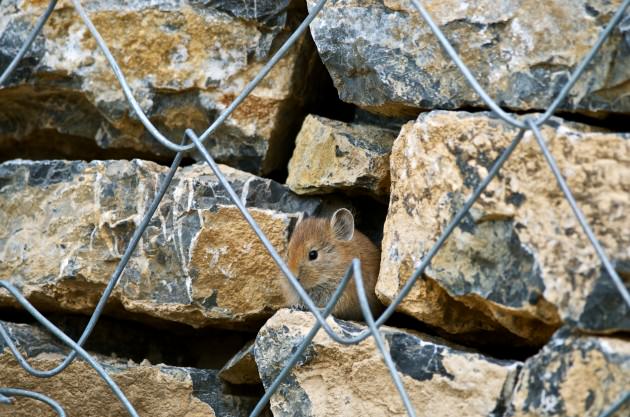
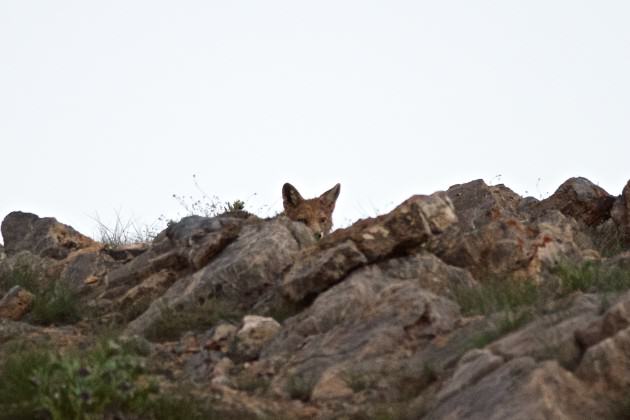
The effects ripple further up the trophic levels of the local food web, with Wolves and Snow Leopards broadening their palate with an occasional helping of goat, yak or donkey. Himalayan Griffon and Lammergeier Vultures soar in the skies scavenging on the kills of these predators, and are also apparently unaffected by the anthropogenic declines among their cousins throughout Asia. Red Foxes take over the alleyways at night, just like their London cousins, but face stiff competition from a growing population of feral dogs, tolerated and subsidized by kindly humans who feed them during the harsher seasons. Echoing the problems now widespread in all Indian cities, even small villages in Spiti host dozens of feral dogs, which venture in packs into the wilder countryside where they take down an occasional Bharal or Ibex, and even livestock, and no doubt many a smaller vertebrate. There are reports of a feral dog in league with a wolf near one of the villages in the Valley.
What about the human side of these old social-ecological systems?
Spitians are a resilient and enterprising people, having survived through centuries of harsh winters while remaining connected with the rest of the world along the old trade routes between south Asia and Tibet. With fewer (and weakening in recent years) caste hierarchies and narrower economic divisions compared to elsewhere in India, Spitian society seems remarkably cooperative, with village councils working together to face the challenges of their cold desert ecosystems. Tibetan Buddhism, the dominant cultural force in the valley through the monasteries built centuries ago, provides a spiritual framework for not just surviving in these conditions, but for doing so while caring for their fellow human beings, animals, farms, and the local wildlife. This combination of an innately cooperative, consensus-based society with religion inspired tolerance and respect for wildlife, has been a key ingredient in NCF’s conservation success in the region. Mishra and colleagues have been able to establish remarkable models for managing human-wildlife conflicts in such places. They help villagers run self-financed livestock insurance schemes to compensate for the depradations of wolves and snow leopards, a model that is now being adopted in other countries facing similar problems. Villages have also set aside grazing preserves for the wild ungulates facing competition from increasing herds of livestock. This level of cooperation and collective management of grazing lands is a rare accomplishment in India, where conflict between local communities and conservationists is more the norm.
The past two decades of the neoliberal economic boom in India has also reached these remote border villages. Cash crops like green peas and apples (in the lower reaches of Spiti) now augment the traditional barley fields and pastures. Improvements in the transportation and communication infrastructure, along with the Indian government’s opening up of the area to outsiders, have brought many more tourists, of the recreational, spiritual, and some ecological varieties. It also allows Spitians, who place a high value on learning, to send their children to boarding schools in larger towns, whence they may seek better opportunities in life. Access to electricity and liquified petroleum gas (LPG) is reducing dependence on dung as biofuel. This, along with lives now busier with newer ventures means more dung remains uncollected than before, allowing more of those nutrients to remain in the pastures. The Caragana lined roofs of the mud houses now sport solar panels and water heaters and satellite dishes amid fluttering prayer flags, even as people are building new concrete structures extending their homes or for home-stay guest houses for tourists. All of this has sparked a degree of upward mobility among the natives who are now relatively well off, thanks to the cash crops and the tourist money.
The ecological footprint of the average native Spitian has grown considerably over the past decade. Mishra notes that even their diet has been completely transformed since he started working in the region almost 20 years ago. Their collective ecological footprint now spills well beyond their watershed boundaries, what with the imports of instant noodle soups and flat screen televisions. Mishra’s native colleagues also worry about the growing disconnect among their youth who seem less interested in the nature around their village, an early stage of that modern urban malaise of Nature Deficit Disorder. An even darker side of this fast, mindless development in fragile mountain regions became apparent during our visit, when the lower reaches of Spiti also experienced some of the destructive power of an intense monsoon storm which devastated nearby Uttarakhand state. The more arid trans-Himalayan regions remained relatively safe from the more extreme devastation this time. But for how long, given the relentless march of “development” in India?
Meanwhile, the increasing affluence also facilitates another feature of modern urban societies: migration of labor. The relatively well-off Spitians are able to hire migrant laborers from the plains (mainly Bihar, Jharkhand, and Nepal) to work in their fields and hotels. These are often children in their early teens, brought up into the mountains by their parents who came up as part of road construction crews, or by labor contractors often operating in the shadows. Itinerant migrant construction workers and farm laborers are a regular feature of cities worldwide, often the source of both cultural diversification and strife. How this relatively big demographic and cultural shift plays out among the peaceful Spitians remains to be seen.
Increase in tourism with greater access and connectivity over the past decade only serves to ratchet up the urbanization engine, accelerating many of the above impacts, both positive and negative. While the cultural impacts of tourism may take some more time to unfold, even the Lamas have become inured to the presence of camera-toting tourists in their monasteries gawking at them as they carry on with their prayers and daily rituals. Catering to tourists has led to the availability of a much more diverse cuisine, which in turn must be supported by increasing imports of various foods (mostly processed) and drinks from farther away. Hotels are being built with modern conveniences such as hot showers and flush toilets (instead of the traditional waterless compost-pit toilets), but without the attendant improvements in the infrastructure for water supply and sewage management.
And then there is the garbage.
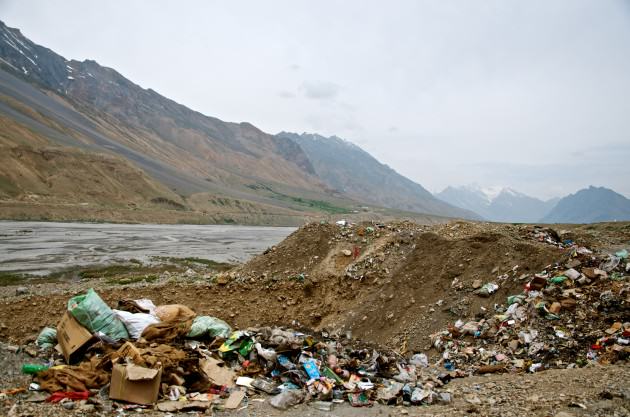
The piles of mostly plastic trash that dot the hillsides and ravines around Spiti’s settlements are perhaps the most conspicuous and ubiquitous sign of urbanization having reached this remote valley. There are no cultural traditions or ecological mechanisms among the native social-ecological systems to deal with this growing pile of non-biodegradable modern waste, even if your hotel provides a falsely reassuring bin in your room. The only “system” is for people in the settlements to collect their household garbage and dump it on the outskirts of the town in unruly piles. So what if the growing pile of garbage with its pack of feral dogs is often the first thing to greet visitors entering a town? Meanwhile, the entire countryside experiences a steady drizzle of plastic garbage: polythene bags (although these have been banned, with most shops offering cloth bags instead), plastic water and soft-drink bottles, packaging ranging from single-use shampoo sachets and candy wrappers to instant noodle soup and bags of chips, children’s toys and shoes, and broken down lost cellphones. Bits of plastic fall steadily across the mountains and valleys, dropped along roadsides by slippery or wilful hands from the windows of buses and tourist cars, from the backpacks of trekkers along trails, and mountain-biking tourists, and from the native homes, picked up, dashed against rocks, and scattered by the winds to form a perhaps more dilute terrestrial form of the infamous Great Pacific Garbage Patch. Eventually, the plastic ends up either ground into the dust, or washed into the river.
Yet it is perhaps not too late to start tackling this problem before it really gets out of hand. In their latest effort to care for the environment of these mountains, Mishra’s team has now begun work to address the problem of managing garbage. Intense meetings held this summer—with men, women, and youth groups—have seen animated discussions about the problem with various solutions being proposed and considered. Some of the village committees have pledged to start taking specific actions, such as providing bins as collection points, identifying potential landfill-sites away from the villages, and organizing regular pick up and dumping of garbage. Kibber’s people have even drafted a garbage management plan to address the growing problem. Given the still high cost of transportation, recycling of plastics is not really an option at the moment, so the best short-term option may be to segregate the biodegradable from non-degradable stuff, saving the former for compost and burning the latter. Organic waste is already part of the natural village agricultural cycle, with traditional composting practices that include the use of human waste from the open-pit water-free toilets, or Chaksas, as fertilizers. It makes sense to strengthen these indigenous solutions and adapt them to the modern waste-flows rather than importing more water-intensive sewage treatment options. Better to educate the tourists about the benefits of water-free Chaksas than install expensive plumbing and flush toilets for their benefit in the new hotels. Glass, and most plastic bottles are also routinely reused many times over. As for the rest of the plastic garbage, burning it may be the best option for now. Perhaps it is time to talk to the Swedes about installing small-scale versions of their garbage-incinerating power plants which can solve two problems at once.
The Himachal Pradesh state government has just announced a ban on use of polythene for packaging non-essential eatables, i.e., junk food. This should go a long way towards both solving the garbage problem and improving public health, although one wonders how they will implement such a radical ban. Will industry and commerce rise to the occasion and invent biodegradable substitutes to package the chips and candies, cookies and chewing gum, ice-cream and instant noodles they like to sell to the local populace? And will they also start packaging the more essential eatables, the grocery staples like milk and oils, dal and rice, in similar biodegradable packets? After all, it is hard to deny the convenience of being able to buy all these products in neat, clean packages, especially in the small single use quantities preferred by most of India’s poorer populations. Hopefully technology will come up with better materials that offer the same convenience without adding unsustainable burdens on the environment. Reducing the amount of garbage should also help control the feral dog problem, which is also a major threat to biodiversity conservation in the area. The big immediate challenge, of course, is the same one facing garbage managers in every city: how to get individuals to cooperate and actually do their part, in segregating their garbage at the source, composting on their own, and reducing the use of packaged processed stuff in the first place. And the much larger issue of all the plastic packaging used for everything these days.
Nevertheless, given their traditions of cooperation and collective action to manage their commons, the native Spitians may yet provide us with models for managing this most widespread of urban problems. And the dogs may yet yield the night to the native Red Foxes even in the larger towns.
Meanwhile, sitting in the German Bakery in Spiti’s district headquarter of Kaza, under the mural of Che Guevara on the wall, sipping an espresso over a slice of warm apple pie, perhaps catching up on your Facebook timeline on your mobile phone, while House Sparrows bicker over crumbs from your table and stray dogs roam the alleys outside, you might be forgiven for thinking, momentarily, that you are in Any City, Anywhere, rather than at some remote rural frontier at the edge of the roof of the world.
You’re not in a village anymore.
Welcome to the global city.
Madhusudan Katti
Kolkata

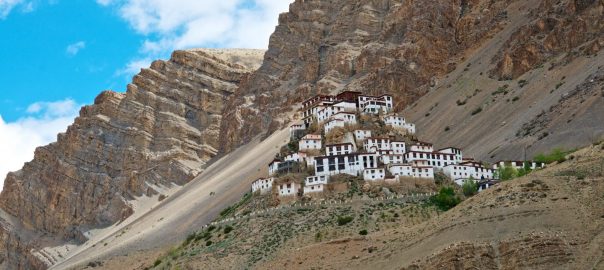








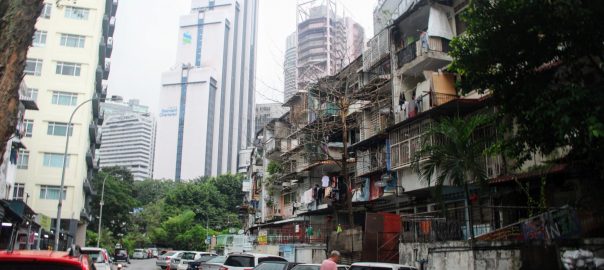
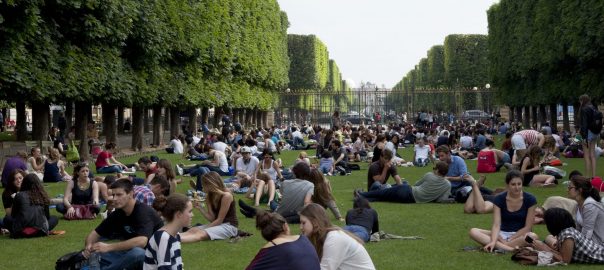
Add a Comment
Join our conversation